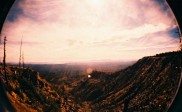The leading guide to panoramic photography
Panorama photos are the process of assembling multiple images of a view into a single wide image. It can be horizontal, vertical or even a mosaic of pictures taken in both orientations. Most digital cameras have a stitching mode to help you capture large panoramas in a series of shots and later gather them in a single digital file. In this article we will talk about how to photograph a panorama, give some tips to consider in photographing panorama and show you some amazing panorama photos to inspire you.
How to photograph a panorama photo
In that video tutorial, you will learn step by step how to photograph a panorama photo, I hope you find it useful.
In that video tutorial you will learn step by step how to stitch the images you took to create the panorama
Tips for photographing panorama photos
1- Using a tripod is highly recommended. It helps keep your images in the same level.
2-Use a wide angle lens zoomed out at the lowest mm length because if you zoomed in, your panorama software will have difficulty in matching up the edges.
3-As you take a series of overlapping images, if you’re photographing on a sunny day, you’ve probably seen bands of light and dark running through the final image, because your camera’s using a different exposure for each shot. It is better to manually expose the first photograph then keep that exposure locked for the others.
4-Be aware of people moving in the stitch. You may have the same person appear in different places from frame-to frame.
5-Grid lines in viewfinder. The grid lines help you to align your camera with the horizon. It also provides guides on ensuring proper overlap between the shots.
6-For best results, ensure you have at least 20%-30% overlap between shots. If you don’t allow enough overlap between frames when shooting, your software may not be able to stitch the frames together properly. Pay attention to the grid lines in viewfinder to make sure the shots are lined up properly.
7-You can shoot a panorama in any direction, from left to right or vice-versa up-to-down and down-to-up .As long as you get sufficient overlap between photos, you can take them in any order you like.
8-Don’t feel limited to photograph traditional panoramas, you can photograph a vertical panorama just as easily as a horizontal one.
9-Do not use a polarizing filter. When you are going to rotate the camera in order to take the pictures, the incidence of the light on the filter will change and this will result in different colors hues on each picture which will be very difficult in stitching.
10- If you’re shooting indoors, remember not to use ‘auto white balance’ because you might see some drastic color changes from one frame to the next because in an indoor situation, you’ll often have a variety of light sources.
11- Shoot in JPEG rather than RAW because large file sizes can cripple your computer when stitching shots together. RAW files give a lot of detail which we don’t really need.
12- If Your Camera has a Panorama mode , try to use it. This helps to adjusts the camera to not change exposure settings from one photo to another, making stitching in the computer a lot easier, and will also help in overlapping the images together.
13- It is best to use the manual focus to make sure that any main focus points in your image are kept to the center of your frame and will not be a part of an overlap.
14- There are a lot of stitching programs for making the panoramic photos but it is easy and will not cost you anything using adobe Photoshop for stitching..
Here are some panorama photos to inspire you
Horizontal panorama photos
Vertical panorama photos

















